São Jorge is an island of cliffs, crags and fajãs, one of the greenest in the Azores archipelago and the perfect place for a holiday in contact with nature and the sea.
The island is 54km long and 6.9km at its widest point, and is part of the Central Group and one of the apexes of the so-called "triangle islands", together with Faial and Pico, from which it is 18.5km away.
From a landscape point of view, the contrast of the central mountain range that runs almost the whole length of the island stands out, with its rugged, jagged coastline, dotted by the typical fajãs that extend into the sea. The fajãs are small plains originally created by lava or landslides and there are over 40 on São Jorge, which has earned it the nickname island of fajãs. In some cases there is only pedestrian access, so the trails are one of the best ways to discover it, using paths that are suitable for various physical conditions and specialist guidance.
From the Fajã da Caldeira do Santo Cristo, the most famous because of its tasty clams, to the Fajã dos Cubres, with its crystal clear lagoon, and the Fajã do Ouvidor with its natural pools, a tour of the island of São Jorge means admiring the land divided into plots for subsistence farming, the stone houses with three-pane sash windows, the waterfalls and the curious steel cables for transporting wood to the coastal plains.
São Jorgeis an island of cliffs, crags and fajãs, one of the greenest in the Azores archipelago and the perfect place for a holiday in contact with nature and the sea.
The island is 54km long and 6.9km at its widest point, and is part of the Central Group and one of the apexes of the so-called "triangle islands", together with Faial and Pico, from which it is 18.5km away.
From a landscape point of view, the contrast of the central mountain range that runs almost the whole length of the island stands out, with its rugged, jagged coastline, dotted by the typical fajãs that extend into the sea. The fajãs are small plains originally created by lava or landslides and there are over 40 on São Jorge, which has earned it the nickname island of fajãs. In some cases there is only pedestrian access, so the trails are one of the best ways to discover it, using paths that are suitable for various physical conditions and specialist guidance.
From the Fajã da Caldeira do Santo Cristo, the most famous because of its tasty clams, to the Fajã dos Cubres, with its crystal clear lagoon, and the Fajã do Ouvidor with its natural pools, a tour of the island of São Jorge means admiring the land divided into plots for subsistence farming, the stone houses with three-pane sash windows, the waterfalls and the curious steel cables for transporting wood to the coastal plains.
This stunning coastal scenery would not be complete without the Islet of Rosais and, off the eastern tip of the island, the Islet of Topo, a nesting ground for many seabirds and home to fine examples of the endemic flora of the Azores. These are the reasons which, combined with the landscape, led to its classification as a Nature Reserve.
In the island’s central plateau, at 1053m above sea level, you will find the highest point on São Jorge, Pico da Esperança, from which you can enjoy unforgettable views over the island itself, closely guarded by Pico, Graciosa, Terceira and Faial. It is at this higher point, an area stretching from Pico do Areeiro to Pico das Caldeirinhas, via Pico da Esperança, Pico do Carvão and Morro Pelado, that the presence of an endemic vegetation of great botanical and scientific value gave rise to three Natural Forest Reserves, which adopted the name of those four peaks.
The various viewpoints scattered around the island, such as Ribeira do Almeida, Fajã das Almas, Fajã das Urzes, Fajã dos Cubres and Norte Pequeno, offer views of undisputable beauty.
São Jorge comprises 2 municipalities, Calheta and Velas. In Vila das Velas, the Portão de Mar (Sea Gate) welcomes travellers from boats docking at the port, sending them on their way to the town’s central square, where they can visit the Parish Church of São Jorge, with the adjoining Museum of Sacred Art, and the Town Hall.
As you walk past Urzelina your eyes will be drawn to a church tower, isolated amidst the landscape, almost completely surrounded by black rocks. It is the only remnant of the original building which was buried by the volcanic eruption of 1808. InManadas, it’s worth noting one of the most interesting examples of Baroque architecture in the Azores, the 18th century church of Santa Bárbara, with its black and white façade and rich interior. Calheta and Topo are picturesque harbours, where ancient houses and churches, such as the Church of Santa Catarina, the São Jorge Museum and the church of Nossa Senhora do Rosário, all have their stories to tell.
Double crochet quilts are still made in wooden looms and the artesans can be found at work in Fajã dos Vimes. The handicrafts cooperative of Ribeira de Nabo is a showcase for these quilts, also known as “São Jorge blankets”.



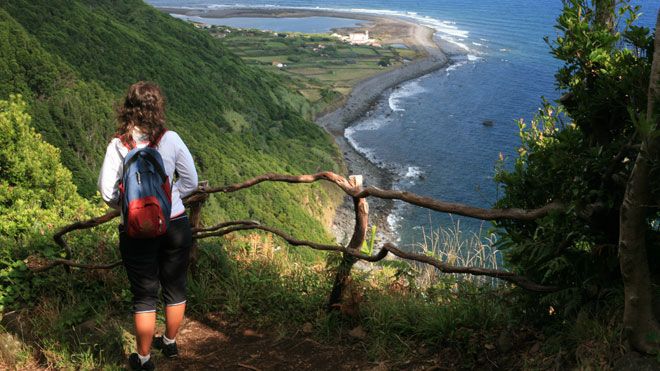







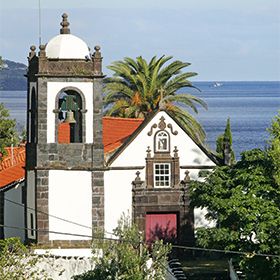
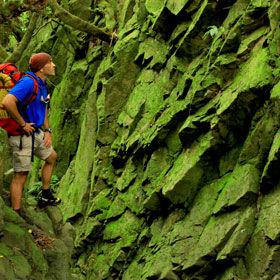

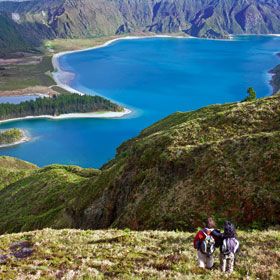


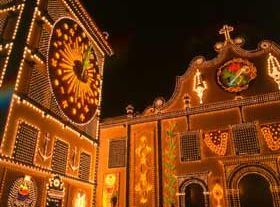
 Explore
Explore 
 Remember and Share
Remember and Share 


